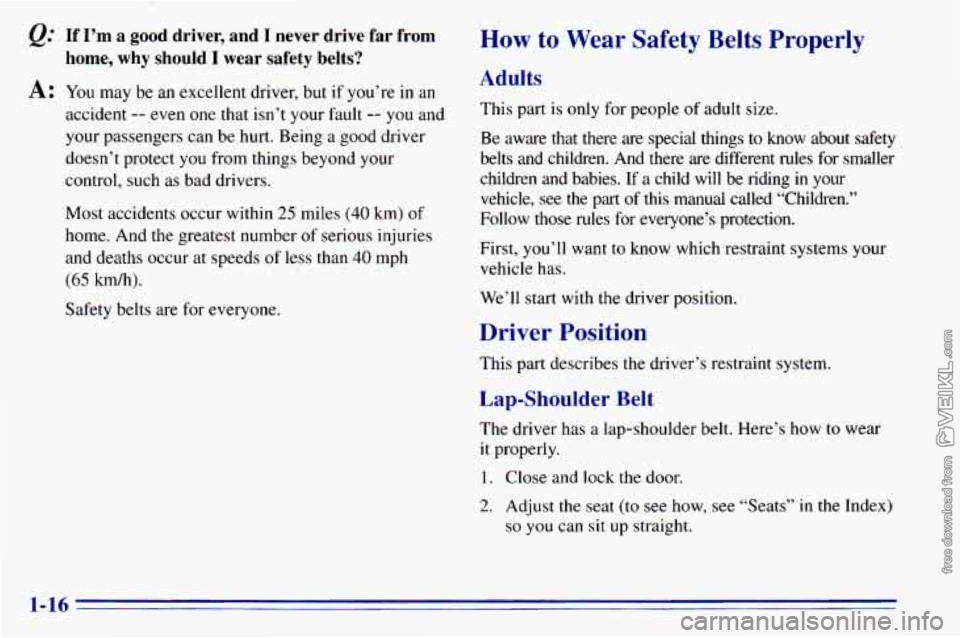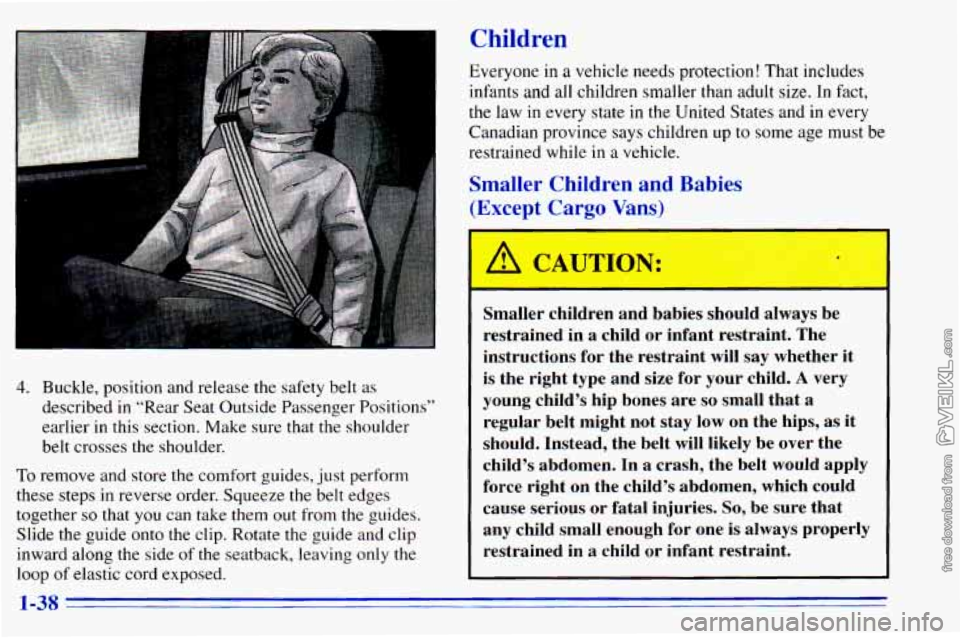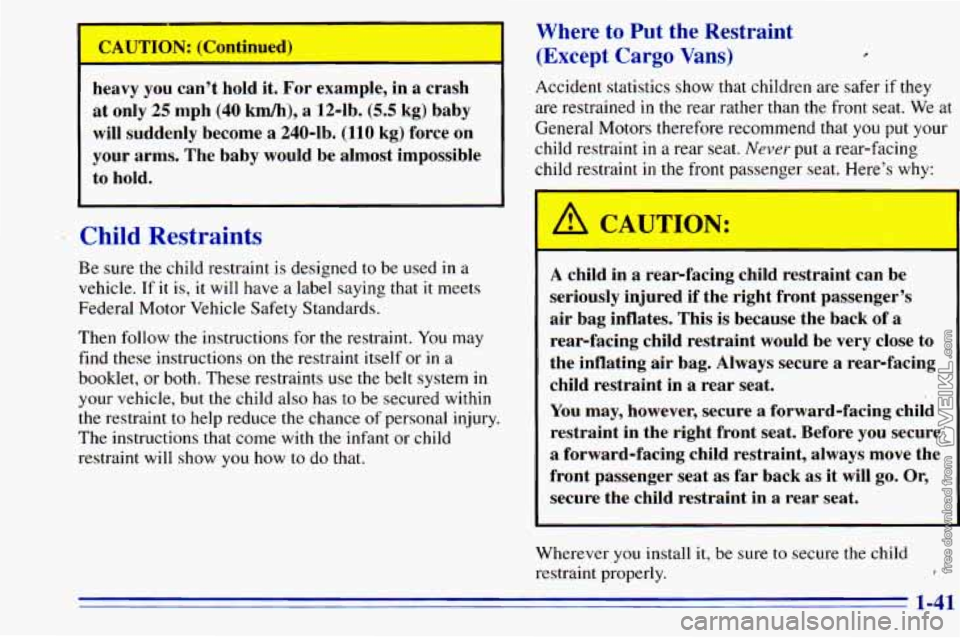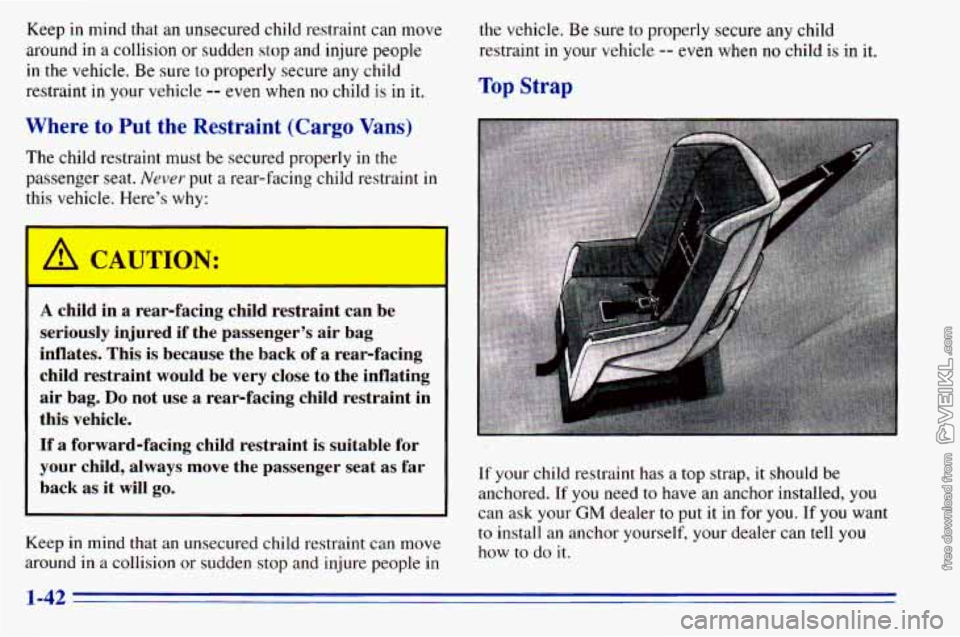Page 24 of 372

@ If I’m a good driver, and I never drive far from
A: You may be an excellent driver, but if you’re in an
home, why should I wear safety belts?
accident -- even one that isn’t your fault -- you and
your passengers can be hurt. Being
a good driver
doesn’t protect
you from things beyond your
control, such as bad drivers.
Most accidents occur within
25 miles (40 km) of
home. And the greatest number of serious injuries
and deaths occur at speeds
of less than 40 mph
(65 km/h).
Safety belts are for everyone.
How to Wear Safety Belts Properly
Adults
This part is only for people of adult size.
Be aware
that there are special things to know about safety
belts and children. And there are different rules for smaller
children and babies. If a child will be riding
in your
vehicle, see the part
of this manual called “Children.”
Follow those rules for everyone’s protection.
First,
you’ll want to know which restraint systems your
vehicle has.
We’ll start with the driver position.
Driver Position
This part describes the driver’s restraint system.
Lap-Shoulder Belt
The driver has a lap-shoulder belt. Here’s how to wear
it properly.
1. Close and lock the door.
?. Adjust the seat (to see how, see “Seats” in the Index)
so you can sit up straight.
1-16
Page 44 of 372
Rear Safety Belt Comfort Guides for
Children and Small Adults
Your vehicle may have rear shoulder belt comfort
guides. This feature will provide added safety belt
comfort for children who have outgrown child restraints
and for small adults. When installed on a shoulder belt,
the comfort guide pulls the belt away from the neck and
head.
There is one guide for each outside passenger position in
the rear seats. To provide added safety belt comfort for
children who have outgrown child restraints and for
smaller adults, the comfort guides may be installed on
the shoulder belts. Here's how to install a comfort guide
and use the safety belt:
1. Remove the guide from its storage clip on the side of
the seatback.
1-36
Page 46 of 372

4. Buckle, position and release the safety belt as
described in “Rear Seat Outside Passenger Positions”
earlier
in this section. Make sure that the shoulder
belt crosses the shoulder.
To remove and store the comfort guides, just perform
these steps in reverse order. Squeeze the belt edges
together
so that you can take them out from the guides.
Slide the guide onto the clip. Rotate the guide and clip
inward along the side of the seatback, leaving only the
loop of elastic cord exposed.
Children
Everyone in a vehicle needs protection! That includes
infants and
all children smaller than adult size. In fact,
the law
in every state in the United States and in every
Canadian province says children up
to some age must be
restrained while
in a vehicle.
Smaller Children and Babies
(Exce: A Cargo Vans)
I--
Smaller children and babies should vays 1
restrained in a child or infant restraint. The
instructions for the restraint will say whether it
’ is the right type and size for your child. A very
young child’s hip bones are
so small that a
regular belt might not stay low on the hips, as it
should. Instead, the belt will likely be over the
child’s abdomen. In a crash, the belt would apply
force right on the child’s abdomen, which could
cause serious
or fatal injuries. So, be sure that
any child small enough for one is always properly
restrained in a child or infant restraint.
1-38
Page 49 of 372

..
CAUTION: (Continued) .. .. .I . . . .. .I. . ,.
heavy you can’t hold it, For example, in a crash
at only 25 mph (40
km/h), a 12-1b. (5.5 kg) baby
will suddenly become a 2404b. (110 kg) force on
your arms, The baby would be almost impossible
to hold.
Child Restraints
Be sure the child restraint is designed to be used in a
vehicle. If it is, it will have a label saying that it meets
Federal Motor Vehicle Safety Standards.
Then follow the instructions for the restraint. You may
find these instructions on the restraint itself or in
a
booklet, or both. These restraints use the belt system in
your vehicle, but the child also has to be secured within
the restraint
to help reduce the chance of personal injury.
The instructions that come with
the infant or child
restraint will show
you how to do that.
Where to Put the Restraint
(Except Cargo Vans)
Accident statistics show that children are safer if they
are restrained
in the rear rather than the front seat. We at
General Motors therefore recommend that
you put your
child restraint in
a rear seat. Never put a rear-facing
child restraint in the front passenger seat. Here’s why:
I
A child in a rear-facing child restraint can be
seriously injured if the right front passenger’s
air bag inflates. This is because the back of a
rear-facing child restraint would be very close to
the inflating air bag. Always secure a rear-facing
child restraint in a rear seat.
You may, however, secure a forward-facing child
restraint in the right front seat. Before you secure
a forward-facing child restraint, always move the
front passenger seat as far back as
it will go, Or,
secure the child restraint
in a rear seat.
Wherever
you install it, be sure to secure the child
restraint properly.
1-41
Page 50 of 372

Keep in mind that an unsecured child restraint can move
around in a collision
or sudden stop and injure people
in the vehicle. Be sure to properly secure any child
restraint in your vehicle
-- even when no child is in it.
Where to Put the Restraint (Cargo Vans)
The child restraint must be secured properly in the
passenger seat.
Never put a rear-facing child restraint in
this vehicle. Here’s why:
A CAUTION:
the vehicle. Be sure to properly secure any child
restraint
in your vehicle -- even when no child is in it.
Top Strap
A child in a rear-facing child restraint can be
seriously injured
if the passenger’s air bag
inflates. This is because the back
of a rear-facing
child restraint would be very close to the inflating
air bag.
Do not use a rear-facing child restraint in
this vehicle.
If a forward-facing child restraint
is suitable for
your child, always move the passenger seat as far
back
as it will go.
Keep in mind that an unsecured child restraint can move
around in a collision
or sudden stop and injure people in
If your child restraint has a top strap, it should be
anchored.
If you need to have an anchor installed, you
can ask your GM dealer to put it in for you. If you want
to install an anchor yourself, your dealer can tell you
how to do it.
1-42
Page 51 of 372
Securing a Child Restraint in a Rear
Outside Seat Position
You'll be using the lap-shoulder belt. See the earlier part
about the top strap
if the child restraint has one.
1. Put the restraint on the seat. Follow the instructions
for the child restraint.
2. Secure the child in the child restraint as the
instructions say.
3. Pick up the latch plate, and run the lap and shoulder
portions of the vehicle's safety belt through or
around the restraint. The child restraint instructions
will show you how. Tilt
the
latch plate to adjust the belt if needed. If the
shoulder belt goes in front of the child's face or neck,
put it behind the child restraint.
1-43
Page 53 of 372
Securing a Child Restraint in a Center Seat
Position (Bench Seat)
You’ll be using the lap belt.
See the earlier part about the top strap if the child
restraint has
one.
1.. .
1. Make the belt as long as possible by tilting the latch
2. Put the restraint on the seat. Follow the instructions
plate and pulling
it along the belt.
for the child restraint.
3. Secure the child in the child restraint as the
instructions say.
4. Run the vehicle’s safety belt through or around the
restraint. The child restraint instructions will show
you how.
1-45
Page 54 of 372
5. Buckle the belt. Make sure the release button is
positioned
so you would be able to unbuckle the
safety belt quickly if you ever had to.
6. To tighten the belt, pull its free end while you push
7. Push and pull the child restraint in different
down
on the child restraint.
directions to be sure it is secure. If it isn’t, secure
the restraint in
a different place in the vehicle and
contact the child restraint maker for their advice
about how to attach the child restraint properly.
To remove the child restraint, just unbuckle the vehicle’s
safety belt. It will be ready
to work for an adult or larger
child passenger.
Securing a Child Restraint in the Right
Front Seat Position
Your vehicle has a front passenger air bag. Never put a
rear-facing child restraint in this seat. Here’s why:
1-46